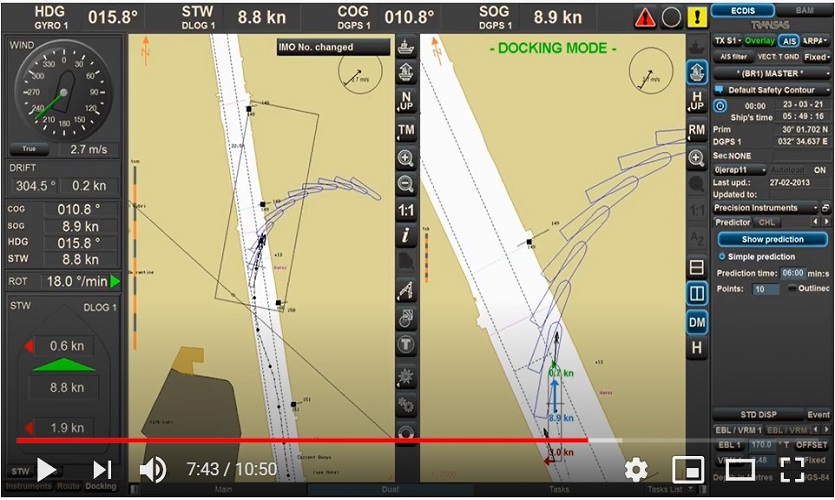Retracing "world's most costly" ship crash on LJMU Maritime Simulator

After the world’s most costly cargo ship accident, maritime expert Dr Abdul Khalique mans LJMU’s £2 million simulator to explain what went wrong on board the Ever Given.
“We’re talking about one of the largest ships ever built – the length of FOUR football pitches – so when you lose control of that, you’re in trouble,” begins Dr Khalique, Head of the LJMU Maritime Centre.
The Ever Given’s collision with the east bank of the Suez Canal on March 23 caused shockwaves around the world. Connecting Asia and the Gulf with European markets, the 120-mile waterway allows passage to 52 container ships each day. Blocked for six days, the balance sheet loss was an estimated £40 billion.
“For every hour the Ever Given was banked, we’re talking £280m in late and lost trade,” explained Dr Khalique.
“At the time of writing, the Japanese owners have refused to pay the Suez Canal Authority compensation of £655 million. As a result, the ship has been arrested. It’s a mess.”
“Further claims will no doubt arise from many other stakeholders whose cargoes were delayed or even (in the case of perishable goods) have deteriorated to the point where they no longer have any value.”
The cause of ship’s trouble that day remains uncertain. However, Dr Khalique has identified three factors that may have contributed to the accident.
What went wrong?
Factor 1 Speed & Wind:
The Suez Canal Authority Rules of Navigation state that a container ship must not exceed a speed of 16 km/hour (8.6 knots). However, Ever Given’s last recorded speed was 13.5 knots. Weather forecasts for showed that winds were expected to gust to over 40 miles per hour.
“For ships like the Ever Given, wind is problematic as containers on deck act like a sail, making it difficult to steer. Increasing speed can improve the ship’s manoeuvrability. This may explain why the Ever Given’s speed was as high as it was,” explains Dr Khalique.
“In this part of the world, strong winds like those experienced are commonly accompanied by a sandstorm and any reduced visibility caused would no doubt have aggravated the already complicated situation.”
Factor 2 – Systems failure:
Modern day ships are complicated pieces of machinery composed of an almost limitless number of systems and sub-systems. Getting to the bottom of which, if any of these, may have failed can be a time-consuming task.
“Once again, the ongoing investigation will consider each of these to determine whether they played a contributing role in the incident. Likely candidates for systems that could have failed and produced the outcome that occurred would be the ship’s propulsion system or steering system.”
Factor 3 – Human Error:
Over the years, depending upon the source, it has been stated that between 75% and 95% of marine accidents can be attributed to human error. Human error is a wide-ranging category but in the case of the Ever Given it could just come down to a simple error in judgement.
“Two issues in particular stand out,” assesses Abdul. “Firstly, a number of other vessels chose to wait for the weather to improve whilst the Ever Given decided to continue despite high winds and a sandstorm. Was safety compromised to avoid falling behind schedule? Secondly, the Ever Given chose not to have tugboat escort whilst other vessels in the vicinity engaged tugs. These escorts come at a cost. Was safety compromised in an attempt to save money?”
Crucially, investigators will look at a lack of training. “There were two Suez Canal Authority pilots onboard, a master, watchkeeping officer, lookouts and a helmsman.
How can we avoid this happening again?
This was not the first accident in Suez, nor the first time it has been blocked but there are a number of options, says Abdul.
Expansion: “Over £5.5 billion was spent in 2015 to expand the canal but this did not provide enough additional width to avoid a blockage being caused by a vessel like the Ever Given. The question of further expansion remains unanswered at this time, but will no doubt be an expensive and time-consuming venture if pursued.”
An alternative route: “The construction of an additional waterway, or rail link, from Eilat (Israel) to the Mediterranean Sea ̶ According to some news reports, the Ever Given crisis has revived discussions around the topic. In truth, many of these solutions are not only very political but they will also require considerable financial investment in addition to years of planning and construction. This is especially the case with the proposed Eilat plans.”
Training: This is the big one, according to the LJMU expert, not least because specific Suez Canal training is not mandatory.
“Regardless of the circumstances that led to the Ever Given incident, the only option to make ships navigating through this waterway safer is to provide ‘Suez Canal’ training to officers. This would need to include both navigating through Suez Canal under normal conditions as well as in the event of a range of other conditions, including things like extreme weather and machinery failure.”
“This is where simulators like ours at LJMU are extremely useful. Any real world training would demand a high cost is required plus run high risks – even creating a new blockage. The most cost-effective approach to delivering this training would be to do so using a ship simulator.”
The £2.5 million simulation suite, at Liverpool John Moores University, can recreate training conditions for any waterway in the world.
Come and find out more at:
LJMU Maritime Centre, Liverpool John Moores University, James Parsons Building, 3 Byrom Street, Liverpool, United Kingdom L3 3AF
Telephone: +44 (0)151 231 2121
Email:Maritime@ljmu.ac.uk
*Dr Abdul Khalique is supported in the Simulations Suite by Technician, Mr Kamil Kaminski.



